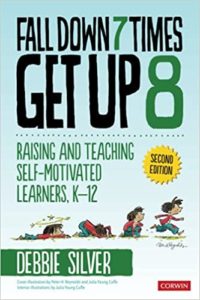A Captivating Dive into Student Self-Motivation
Fall Down 7 Times, Get Up 8: Raising and Teaching Self-Motivated Learners, K-12
By Debbie Silver
(Corwin, 2021 – Learn more)
Reviewed by Kathleen Palmieri


Self motivation, not extrinsic praise
The first chapter provides the catalyst for the idea of helping our children become self-motivated.
Self motivation is a learned skill and important in building lifelong learners. As Silver writes, “It is critical for students to become intrinsically driven and ready to pursue knowledge unconventionally through whatever resources they need to attain their goals.” (page 5)
As we read deeper into this first chapter, Silver hits the nail on the head as she delves into the popular belief that praise is needed in order to help kids feel good about themselves:
I am convinced that neither I nor anyone else can inspire a child to be successful long term through superficial praise, external rewards, or a reluctance to give them accurate feedback. Positivity is good, but it needs to be grounded in progress toward specific goals. (page 7).
Silver believes that with the proper feedback, children are “intrinsically motivated….they can learn all sorts of necessary skills and self-sustaining learning practices.” (page 15)
ZPD in the classroom
Chapter 2 revisits “The Zone of Proximal Development” (ZPD) and how this motivational theory can be used to help students learn to recover from failures and “encounter experiences that stretch them beyond their previous limits.”
Silver maintains that ZPD helps push the student just beyond their level of understanding, creating a “positive tension for learning.” (page 37) Then Chapter 3 dives into what can happen when learners get into that optimal state of learning.
In this chapter I found one of my biggest “yes” moments. Silver discusses the term “helicopter teachers” which is very much the same idea as “helicopter parents.” This is where teachers tend to take over the learning for the student, and – in the words of Penny Kittle and Kelly Gallagher –
Too often in trying to help students, teachers do too much of the thinking. Students come to rely on formula and standardization – and when formula and standardization take hold, the energy and intellectual rigor that comes from creation gets lost. Students become disengaged. (page 51)
Growth mindset plus gifted kids
As I am an avid reader of anything to do with “growth mindset,” I found Chapter 5 exceptional. It discusses Dr. Carol Dweck’s theory and how it helps kids “succeed in school.” This chapter also “explores the unique nature of children identified as gifted and talented and how parents and teachers can utilize growth mindset practices to keep G/T students moving forward.” (page 85)
The added resources in this chapter really resonated with me, such as the scenario “Elizabeth’s Dilemma,” various tables, and the continued discussion of “Fixed Mindset/Growth Mindset.”
Chapter 5 also offers a discussion of “Gifted Kids and Coping With Failure” and “Gifted Kids and Fixed Mindsets.” Silver writes:
“And once the student is labeled as gifted, there is often an added pressure to be superior in every aspect of life. Fixed mindset can lead to that killer of joy – perfectionism.” (page 103)
Growth mindset can therefore “inspire [gifted kids] to new heights,” but as Silver writes, this can lead to a situation where “…they can begin to doubt their ability” when they are put with “peers of equal or even superior ability.” (page 104)
Essential reading!
This book is captivating – it has so many parts that resonated with me. As I read, I found myself in that rare and wonderful place readers long for – feeling as though I was having a conversation with the author. The ideas and concepts Silver discussed were truly issues and thoughts I’ve had in and about my own classroom.
Throughout the book are interesting QR codes, such as the one found on page 47 which leads to a YouTube video of John Stossel on “Free Range Parenting” – or on page 105 “Rethinking Giftedness” which shares how kids feel about being labeled as “gifted.”
Each chapter offers reflection questions and a “Try This” section that I found to be a great resource. Finally, the glossary in the back of the book offers many educational “buzzwords” and their definitions.
I highly recommend Fall Down 7 Times, Get Up 8 to any K-12 educator. In my opinion, this book would be a great pick for a professional development book group or a literacy committee book chat.




























